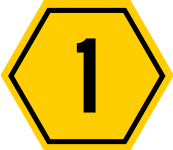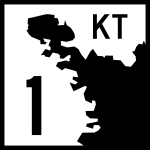User:Lemuria/Lutang/Mapping conventions
The mapping conventions for Lutang.
Ultimately,
Addressing
Lutang's city and municipal governments use a variety of addressing and house numbering systems. But there are always exceptions. The addressing systems of Lutang can be bluntly described as a hot mess of complicated systems with exceptions that the Lutang postal worker must memorize to work with the Lutang Post.
Format
The format is:
- [N] Street, [Quarter/Village], [City], [Province], Lutang
For Bagong Bandila, it is common practice not to write "Greater Bandila Area". But for other towns near BB, writing it is common.
Examples
- This Verona Coffee location in Limingan is located at: 50 Archanta Street, Limingan, Bagong Bandila, Lutang
House numbering
The city governments of Lutang just can't agree on how to number buildings. However, there are many patterns and behaviors that almost everyone has agreed on.
- Buildings get the address of the street where their main entrance is.
- If a building has multiple entrances of equal prominence, higher road classifications always win.
- Compounds of buildings share one house number. Separator determined by
lem:addr:compound_separatorEach building in the compound gets another number, like 69A (letter), 69-1(dash), or 69.1 (period).
Systems
- Sided evenness: One side gets odd numbers and the others have even numbers.
- N-center: Instead of going from the beginning of a street to the end, you center the numbers on N and work from there as you map the buildings. Check
lem:addr:n_center.
This table is non-exhaustive. Please check lem:* tags on administrative boundary relations.
Boundaries
Lutang's administrative division system is closely modelled after that of the real Philippines. OSM Philippines admin_level= conventions thus apply to Lutang. Always use relations to define these boundaries.
| admin_level= | |||||||||||
|---|---|---|---|---|---|---|---|---|---|---|---|
| Country | 1 | 2 | 3 | 4 | 5 | 6 | 7 | 8 | 9 | 10 | 11 |
| Lutang | National border | Provinces | Sectors, subdivisions of provinces | Cities, municipalities, and towns | City districts (groupings of several barangays) | Barangays | |||||
| Examples | Lutang (AR004)∈⊾ | Peninsulang Ines∈⊾ | Metropolitan Bagong Bandila Sector∈⊾ | Payagin∈⊾ Bagong Bandila∈⊾ Araminta∈⊾ |
Araminta Port Sector∈⊾ | Hallauer∈⊾ | |||||
Lutang provinces (admin_level=4)
See this overpass query to regenerate the listing.
| Code | Province |
|---|---|
| AL | Alukana Norte |
| BB | Greater Bandila Area |
| BT | Batis |
| ES | East Sundin |
| HU | Huntsman |
| IN | Peninsulang Ines |
| JI | Jolly Island |
| KA | Peninsulang Kaligtasan |
| KD | Kendeng |
| KI | Kaitang |
| KT | Katumangan |
| LA | Lathala |
| LH | Likhaan |
| LS | Litsaanan |
| MA | Matas |
| MT | Mitaan |
| RM | Rumaan |
| TN | Tambayan |
| WS | West Sundin |
Relations
Do not use roads as boundaries. Do not map landuse as relations that include roads as inner ways. It is acceptable to use relations for larger areas, natural landuses (forest and farmland, etc.) where it is less cumbersome to update. DO use only relations for boundaries.
Names
Language
Urban areas, such as Bagong Bandila, are mapped in English, while rural areas are mapped in Tagalog. Use name:en and name:tl as needed. The main name= field can be bilingual, in transitional areas, or simply if the mapper feels like it.
Example for Bagong Bandila:
name=Bagong Bandilaname:en=Bagong Bandila(English)name:tl=Bagong Bandila(Tagalog/Filipino)name:tl-Tglg=ᜊᜄᜓ︀ᜅ᜴ ᜊᜈ᜴ᜇᜒᜎ(Tagalog in Baybayin)
Do not translate Tagalog names; name:en=New Banner
When using bilingual name=* fields, the following language pairs are acceptable:
| Languages | Examples |
|---|---|
| English / Tagalog in Latin | Anna's Road / Daanan ni Anna |
| Tagalog in Latin / Tagalog in Baybayin | Daanan ni Anna / ᜇᜀᜈᜈ᜴ ᜈᜒ ᜀᜈ᜴ᜈ |
The order is important. English/Tagalog bilingual names are written with the English name first, and then the Tagalog name. name=Daanan ni Anna / Anna's Road
Preferred translations
Translations to use:
| English | Tagalog | |
|---|---|---|
|
| |
|
| |
|
Expressway |
Daang Mabilis[1] | |
| Railway yard | Paradahang pang-tren[2] |
Embassies
Embassies should use English for name, with separate name:en, name:tl tags, and an additional tag with the embassy's name in the language of the receiving country (Mallyore's embassy has name, name:en, name:tl, and name:hr (Croatian)).
Tag names
Help:Tagging prescribes the use of name:ingerish as opposed to name:en. This is to be disregarded. Continue to use name:en, and name:tl. As a compromise, both name:en and name:ingerish can be used; however using only name:ingerish without a name:en tag is unacceptable.
The only exception is for conlangs with no real-world equivalent, use name:languageName as prescribed; for example name:izaki.
Places
place=
|
Use for |
|---|---|
country
|
Lutang itself, at admin level 2 |
province
|
Provinces at admin level 4 like Huntsman (place at geographic center or as close to it as possible) |
city
|
Cities at admin level 6 |
town
|
Municipalities that are not considered cities |
quartervillage
|
Barangays (urban ones are quarters and rural ones are villages) |
hamlet
|
Very small places |
suburb
|
Districts in cities (admin_level=8)
|
Transport
Roads
Types
highway= →
Descriptions ↓ |
highway=
| |||||||
|---|---|---|---|---|---|---|---|---|
| motorway | trunk | primary | secondary | tertiary | unclassified | residential | service | |
| Description | Controlled-access highway. No intersections or traffic lights. | National route network or major routes through cities. | Less major roads through cities, and provincial roads. And less important sections of the N roads. | Important but not minor roads through cities - the main throughfare for local traffic or a barangay, or in provinces, between towns 10k-50k. | Minor roads, main roads in gated communities. | Roads without houses. | Roads with houses. | |
| Numbering | E1, N1, XX 1 | N1, XX 1 | XX 1 | |||||
- XX is a placeholder for provincial designations.
Shields
Numbering
Lutang's expressways (motorways) are numbered EN. These numbers are incremented and are thus in order of expressway construction. National roads that are not expressways begin with NN. North-south roads use even numbers while west-east ones use odd numbers. Roads that go both directions, or ring roads like Bagong Bandila's N69, can use either an odd or even number.
Roads may have additional province-specific designations (AA N with a space!) in addition to their National N number. If an E or N road passes through a province, its number under the province-specific designations may not be used for other roads except itself. The N8 runs through Kendeng and thus has the provincial ref KD 8.
highway=
|
Number range |
|---|---|
| motorway | 1-50 |
| trunk | 51-99 |
| primary | 100-500 |
| secondary | 501+ |
Spacing
When roads are represented by two parallel ways; a certain amount of spacing is expected.
Lutang design standards require each motorway lane to be 4 meters wide. The median is usually 3 meters, so your 2-lane motorway will have 20 meters between both ways.
Trains
Lutang's railway network uses 1435mm standard gauge. The distance between the platform edge and track centerline should be at least 1.8m, for loading gauge.
Lutang Lines, the passenger railroad company has electrified most of its network.
The four freight companies of Lutang are:
- Batis Island Railroad (BIR), serving Batis Island
- Huntsman Rail (HR), serving Huntsman Island
- Gahak & Siritangan Railway (GSR), serving the northern portion of Main Island
- Solidago & Araminta Railway (SAR), serving the southern portion of Main Island
All four run their own private lines; but the GSR and SAR sometimes run on LL lines where LL trains are prioritized. LL services on Batis & Huntsman run on BIR & HR tracks respectively; where freight has priority. Outside of the Lutang Lines network; tracks are mostly unelectrified. LL's electrification is 25kv 60hz overhead line.
Line naming
In order of precedence, name rail lines as:
- Operator
- [OPERATOR] Name of line (e.g. Caluya Line or Bagong Bandila Subdivision)=
- Use abbreviations in the name tag and use the full operator's name in the operator tag.
Tagging
Lutang Lines tracks:
railway=rail gauge=1435 voltage=25000 electrified=contact_line frequency=60 operator=Lutang Lines railway:traffic_mode=passenger
Buses
Bus stations should be named after the place they primarily serve. Prefixes are also added. Write them out in full, no abbreviations.
- Opposite, or Opp. for the other side of the road. The Lutang Mapping Authority has a bus station outside it; and across the road is a station named "Opposite Lutang Mapping Authority".
This website has information on the Singapore bus system; which is a major source of inspiration for the Bagong Bandila bus network.
Bus companies
Lutang has its fair share of provincial bus companies too, just like the Philippines. However, these companies very rarely run routes from Bagong Bandila to random places in the countryside, focusing more on supplementing the railway network.
| Company/organization | Area | Notes |
|---|---|---|
| Lutang Bus | Bagong Bandila | Operated by the Lutang Department of Transportation |
| Little Bird Lines | Nationwide | |
| Islecoach | Katumangan Island | |
| Batibus | Batis Island |
Relations
Naming
- Transport route relations should be formatted as: "LINE_NAME - START --> END".
- Route relations should be named as "<ref> <start> --> <end>".
- Adding "(<A>)" at the end where A is a province, city, or completely arbitrary division is OK if routes must be expressed by more than 1 relation due to node count or other considerations.
Route master
Network relations should not be used. Rather, simply use network tags on routes & route masters.
- Lutang Expressways for the expressways which start with E
- Lutang Trunks for the trunks that start with N




